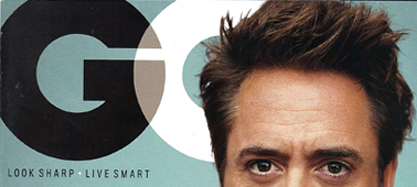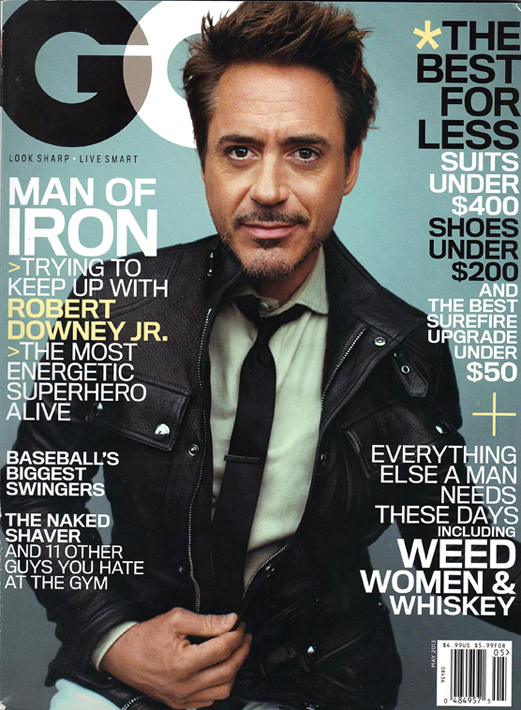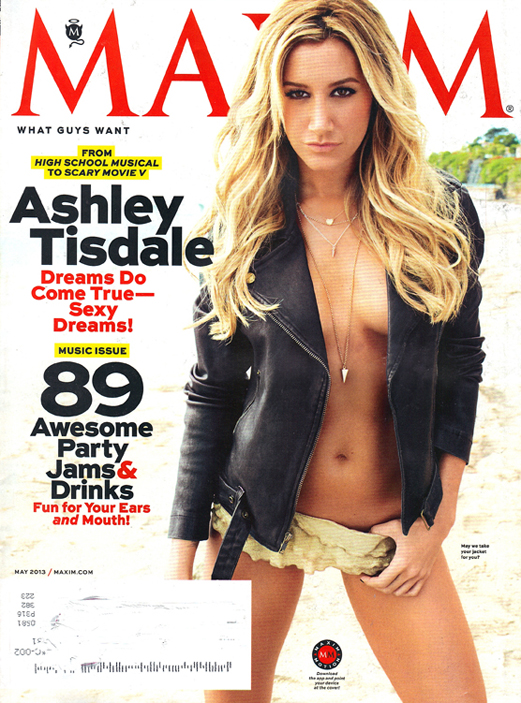| While Maxim displays a semi-nude Ashley Tisdale and GQ displays a fully clothed Robert Downey Jr., the layout of both covers are similar. Both covers place the magazine's name at the top of the page, both display celebrities as the most salient aspect, both celebrities take up the center and majority of the cover with text in the margins, both celebrities are making contact with the reader through direct, demanding gazes, both celebrities are white, and both Tisdale and Downey Jr. are sporting a black leather jacket. |
 |
 |
By using Gunther Kress and Theo van Leeuwen's concept of information value, which states "the placement of elements... endows them with specific information values relative to each other" (Kress & van Leeuwen 176), several key ideologies begin to surface. First off, by placing the title at the top, it begins to represent the ideal. The ideal, in contrast with the bottom and real, places emphasis on the idea of what should be, but not necessarily what can be. In context to the two magazines, Maxim's title is symbolic of what guys should want and what guys should be like. With GQ, the title represents what looking sharp and living smart should look like, and what a man who wanted to buy into the magazine's ideologies should dress, act, and be like. By placing the two celebrities in the center of the cover, they become the most salient aspect of their respective covers. The text in the margins represents what is inside the magazines, but more importantly, they represent the link between what each celebrity represents and how to either become or possess what is being depicted. |
| With a woman on Maxim's cover and a man on GQ's, their meanings and the ideologies of the magazines begin to differ from each other. Structured by Laura Mulvey's male gaze, the two magazines are meant to be viewed from a male's perspective. Therefore, Ashley Tisdale is meant to be desired as an object and Robert Downey Jr. is meant to be identified with. In Matthew Hall and Brendan Gough's article regarding masculinity and metrosexuality in magazines, they display the strong bond between a celebrity and male identification. By using examples of David Bowie, David Beckham, and Cristiano Ronaldo, Hall and Gough show how a semi-taboo trait such as metrosexuality can be easily justified by connecting it to a celebrity in which people can identify with. Similarly, by identifying with Robert Downey Jr. (or Ashley Tisdale), one can justify any behavior or habits outside his norm. By looking at the covers alone, there appear to be two paths one can take to reach ideal masculinity: desire a female or identify with a celebrity who knows how to look sharp and live smart. Once inside the magazine, however, these two paths intertwine and become far less clear-cut. By comparing and contrasting the content of each magazine's advertisements and articles, while discussing the visibility and invisibility of heteronormativity and race, ideas of how Maxim and GQ visualize masculinity become clearer. |
  |



